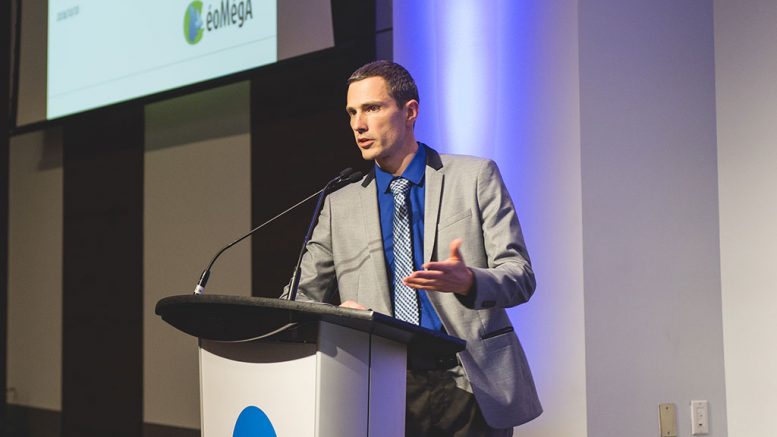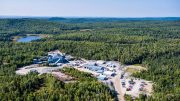Geomega Resources (TSXV: GMA) plans to put Canada on the map as a producer of rare earth elements (REE) — not by building a mine, although it hopes to do that one day too — but by initially recycling them from the permanent magnet industry with a technology developed by its privately controlled subsidiary, Innord.
Geomega claims Innord’s in-situ recovery (ISR) technology, which has been developed over the last five years, can separate and extract rare earth oxides from the waste left over from the manufacturing of permanent magnets as well as from permanent magnets in motors used in wind turbines and electric vehicles that have reached the end of their lives. It can then sell the rare earth oxides it extracts to end users.
“Rare earth magnets are the future of the rare earth industry, and developing the recycling of permanent magnets and permanent magnet residues is just as important as developing new mines,” says Kiril Mugerman, president and CEO of Geomega and Innord.
“Electric vehicles need magnet-based motors. Permanent magnets need rare earth oxides. To make rare earth oxides you need raw materials. While we own a world-class REE deposit in Montveil, current market conditions make it difficult to develop new rare earth mines, and Innord’s ISR technology can process various feeds, which gives us a major advantage to be able to start producing rare earth oxides from such an important industrial source.”
The Montreal-based company says it has processed 2 kilograms of magnet waste feed during each batch of the process at its mini-lab in Montreal, and plans to raise $2 million over the coming months to build a plant that can process recycled feed on a larger scale, and generate over $10 million a year in sales for a profit margin of $2.4 million, or 24%. With those numbers, Geomega says, it can pay off the cost of building the plant in just 12 months.
“We are targeting to process 500 tonnes of magnet waste a year, and 500 tonnes of waste represents 1.5 tonnes of waste processed per day,” Mugerman says in a telephone interview from Montreal. “So annually you’re looking at approximately 175 tonnes of rare earth elements.”
The plan is to increase 500 tonnes of magnet waste a year to 2,000 tonnes a year, or 6 tonnes of waste per day.
Once the company raises the $2 million it needs to build the plant, it will take nine months to finish construction, meaning that Canada could become a rare earths oxide producer as early as a year from now, Mugerman estimates.
The mining executive says average direct-operating costs for third-party-sourced magnet feed grading 30% total rare earth oxide (TREO) is US$3 per kilogram of TREO.
Geomega looks to build the plant somewhere on the south shore of Montreal.
While Innord has been fine-tuning its proprietary REE separation technology, Geomega has been lining up sources of feed to recycle. Last October, Geomega signed an agreement with a magnet manufacturer in Texas to acquire up to 1,000 kilogram per month of feed material and process saleable +99% neodymium and dysprosium oxides. Under the non-binding letter of intent, that amount can be raised to 2,000 kilograms per month if both parties agree.
In November, Geomega signed an agreement with the University of Liège in Belgium to test its ISR technology using rare earth element concentrates produced by the university from magnets in hybrid and electric vehicles.
Geomega notes that neodymium magnets are an important component of motors in electric vehicles and wind turbines, and that more magnets will become available as these products are discarded and recycled in the future. Steel and copper recycling is well established, but recycling permanent magnets out of these new and more efficient motors is limited, Mugerman says. China has a ban on importing permanent magnet scraps, and as a result, Innord’s ISR technology offers a clean and alternative solution for the growing supply of permanent magnet scraps.
“Right now there is no magnet recycling capacity outside of China. Since 2012, they haven’t been importing magnet waste, so that became a window of opportunity to demonstrate our technology through magnet recycling and generating cash,” he says. “These are difficult processes to develop if you want to call them green and be economic, so it took us five years of research and development work to allow us to say it’s a great business model.”
Earlier this year, Geomega signed a letter of intent with Rocklink GmbH, a rare earth, cobalt and minor metals recycling company based in Germany to acquire up to 100 tonnes per year of feed material, such as production residues and end-of-life scraps, which can increase to up to 200 tonnes.
Innord’s ISR technology is a proprietary extraction and separation process based on aqueous chemistry. The process doesn’t generate any greenhouse gas or wet tailings, Mugerman says, and can recycle its reagents at recovery rates of 90%. “We don’t do any roasting, it’s a green, innovative chemistry,” he says. “The only waste we produce is an iron product, and we can sell that to the iron industry.”
In China, by contrast, the magnet waste is dispatched to the very same processing facilities that produce rare earth oxides, he continues.
Once Geomega’s ISR technology is de-risked through magnetic feeds and cash flow, the company plans to expand towards other industrial feeds and mines. Those sources could include its own Montviel rare earth carbonatite deposit in Quebec, 100 km north of Lebel-sur-Quévillon, and a 57 km drive from Highway 113.
The 99.1 sq. km property hosts a resource of 82.4 million indicated tonnes grading 766 parts per million praseodymium oxide (Pr2O3), 2,452 parts per million neodymium oxide (Nd2O3), and 1,715 parts per million niobium pentoxide (Nb2O5) for 1.51% total rare earth oxides (TREO). Inferred resources add 184.2 million tonnes of 746 ppm Pr2O3, 2,433 ppm Nd2O3 and 1,315 ppm Nb2O5 for 1.43% TREO.
“Building a mine is just too risky. But once you have processing capacity built, it’s much easier to look at developing a mine,” Mugerman says. “We said, if a mine is to go into production, we’ll need technology developed first. We’ll build a small producing and operating plant, which is much more reliable than a pilot plant.”
Montviel carries a 2% net royalty to Osisko Mining (TSX: OSK).
Geomega trades at 15¢ per share in a 52-week range of 6.5¢ to 19.5¢. It has 91 million shares outstanding for a $13.6-million market cap.





Be the first to comment on "Geomega fine-tunes rare earths recycling technology"